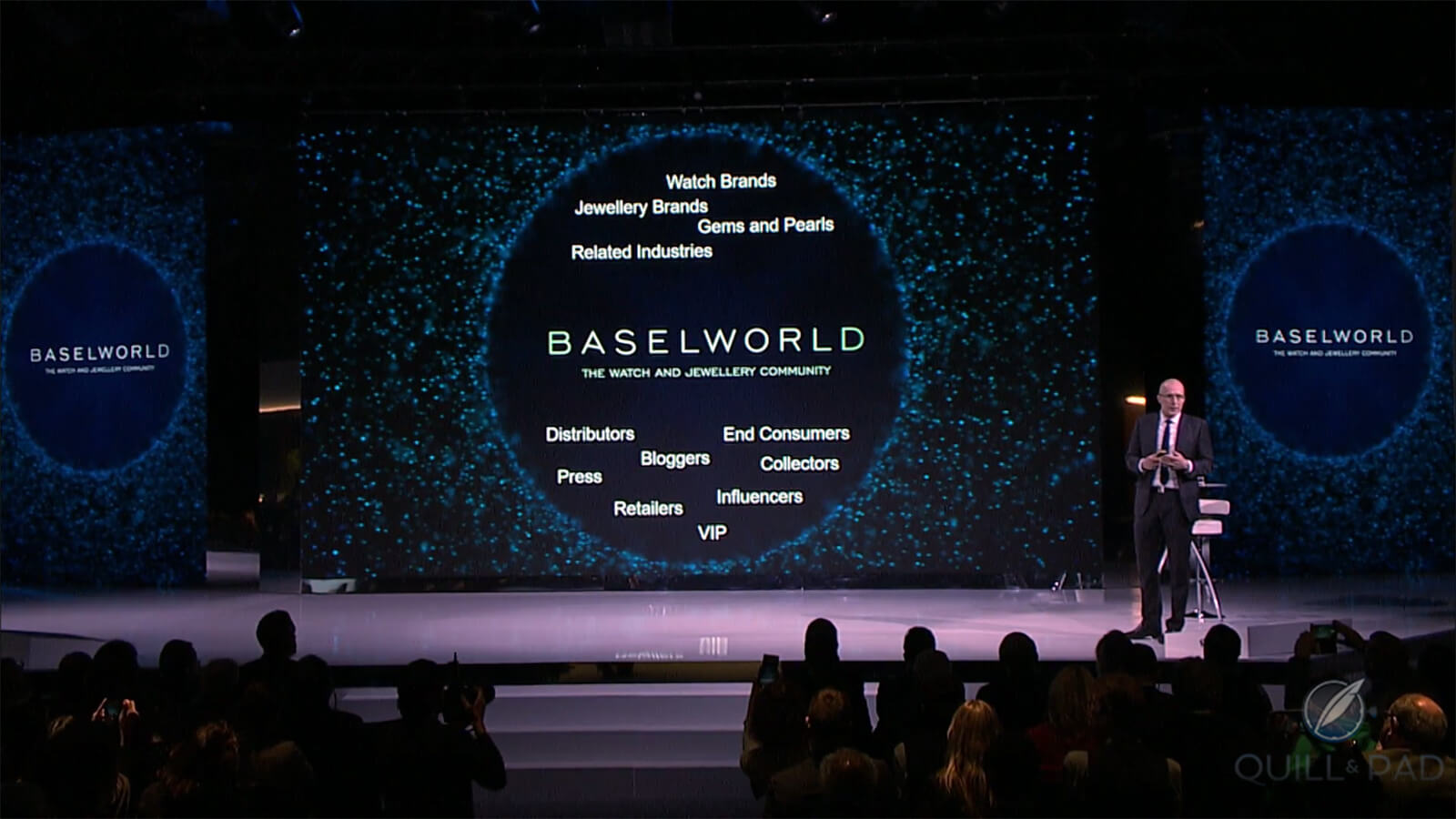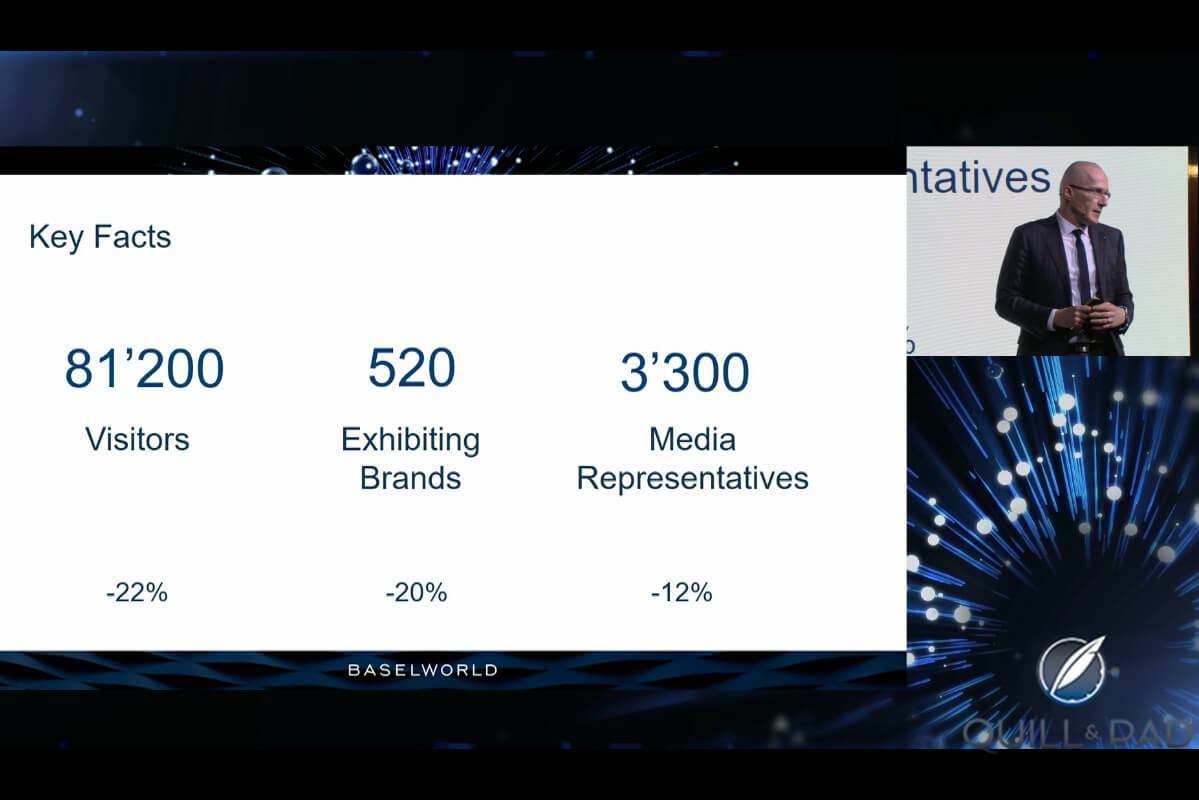Baselworld is fighting for its life. That is not a new story, but one that has been more than apparent for close to three years as exhibitor numbers started sinking. In 2016 there were about 1,500 exhibitors (down from more than 2,000 previously); in 2018 about 700; and this year (2019) there were precisely 520.
Today, the final day of Baselworld 2019, Baselworld’s new director Michel Loris-Melikoff, who took the reins on May 25, 2018, introduced the concept of the fair going forward during a livestreamed press conference from the fair’s new show plaza in Hall 1.2. And his plans should interest the watch community greatly.

Baselworld’s new director Michel Loris-Melikoff giving the closing press conference of Baselworld 2019
Loris-Melikoff spoke flipping between three languages with ease, but mainly in French (though there was simultaneous translation into several languages).
This is a Swiss problem, unfortunately: only 19 percent of Swiss are native French speakers, but the majority of watch companies are based in the French-speaking part. However, Baselworld (and the SIHH, and the Grand Prix d’Horlogerie de Genève, and, and, and) strive to be global entities! I must admit I am still shocked that they haven’t understood that English is spoken and understood by the majority of the (business) world as well as consumers.
The numbers Loris-Melikoff provided were interesting and for once likely closer to the truth than ever: Baselworld 2019 had 81,200 visitors (down 22 percent over 2018); there were 520 exhibiting brands (down 20 percent over 2018); and 3,300 media representatives attended the show (down 12 percent over 2018).

Baselworld 2019 by the numbers
The fair did report increased digital reach, however, with a variety of new initiatives including a new (and decidedly more useful) app, a chatbot, e-mail newsletters, and more. The new app provides access to new services and a map of the fair – but Loris-Melikoff reported that, for example, the toilets did not show up in the plan. He promised this would be improved for next year.
Full transformation underway for Baselworld 2020 and beyond
At Baselworld 2019 – which was in flux and not to be taken as the permanent state of the fair going forward – new initiatives such as the show plaza for “fashion shows” in Hall 1.2, an element directed at end consumers, retailers, and buyers to showcase jewelry creations, all worked well.
There was new catering, vastly improved over previous years. This included a variety of different restaurants inside the fair, from sit-down gastronomy (which was fast and good, though not cheap!) to “grab-and-go” places for even quicker and slightly cheaper solutions, plus a champagne bar in Hall 1.0.
The two restaurants just outside the halls – one of which has offered Japanese noodles since 2013 – were also still in operation, though the pavilion restaurants outside in the square had disappeared.
During the closing press conference Loris-Melikoff revealed there is a new concept in planning for the outside areas.

The central square outside the halls at Baselworld 2019
The future of Baselworld: pricing structures
Loris-Melikoff made it clear that he and his team have been listening to what exhibitors and visitors to the fair have been saying. Step one was to get hotels and restaurants in town on board to avoid the price gouging that had become tradition during Baselworld.
In order to do that, the fair partnered with a variety of hotels and restaurants to keep prices saner, and Loris-Melikoff reported that these affiliated hotels were filled to 75 percent capacity. This is surprising to me; I would have thought they would have been filled.
Baselworld’s pricing structure is probably the single biggest problem the fair has been facing; high prices are a problem for all fairs. And quite possibly – aside from the changes to modern retail structures – this could be the root of the problems for all fairs.
The majority of the high prices are related to the booths and stands as well as additional services needed for them like personnel and catering. Loris-Melikoff says to expect 10-30 percent reduction for exhibitors in this area going forward.
What else will be new at Baselworld?
While Loris-Melikoff and his team reported positive feedback on the new configuration of Hall 1.0 in 2019, which featured the area left by the Swatch Group pavilion replaced by a restaurant and new state-of-the-art press center, don’t expect it to remain that way for the 2020 edition.
There was a legal reason for the way this was set up: the Swatch Group had already paid for this space (the group abruptly announced its departure from the 2019 show just a few months prior) and dictated no other brand could occupy it.
However, I must say that the open look could well have been a reflection of a new, more open style of communication between the fair and the watch/jewelry world. While it isn’t perfect (what ever is?), it was certainly better in many ways.
The enhanced working conditions for the press in the new location in Hall 1.0 were much improved. The press center will be continued, by the way, in this vein but likely not in same location as this prime real estate will no doubt go to brands.
There will also be more stages set up around the fair.
“You spoke, we listened”
Loris-Melikoff revealed having had 829 meetings since he was hired in May 2018; that is a lot of information to digest. But he seems to be making the best of what he’s heard and believes should be done.
For 2020 and beyond we can expect new VIP and collector areas, a continued state-of-the-art press area, and events and services for consumers including digital, e-commerce, talks, and shows.
“Embracing the change,” as Loris-Melikoff explained. He is initiating popup events around the world during the year, plus “experience platforms” at future editions of Baselworld that include hospitality platforms, event zones, a retailer summit (that he already wanted to make work for this year, but couldn’t due to lack of time), CEO talks, and even an e-concierge to provide travel help on the new Baselworld app, which will be launched in next few weeks.
Let’s hope it all becomes concrete and that promises are kept!
Such large changes cannot be implemented in just one year: Loris-Melikoff expects a three-year transformation period with regular announcements over the next weeks and months.

Baselworld 2019: Hall 1.0 on Monday afternoon
Baselworld 2020 dates
The timing for the following years were determined by coordinating and harmonizing dates that “come from within the industry”; both Baselworld and SIHH – who have announced coordinated dates from 2020 through 2024 – looked for timing that fits and suits as many visitors as possible.
For the week-long fair, Baselworld needs the exhibition premises for three months to build and tear down of all the booths and related activities. SIHH needs its hall within the Palexpo for two months as well.
When you take Christmas, Chinese New Year, the Geneva Motor Show, and ever-changing Easter into account, finding suitable dates was an incredibly difficult task.
Unfortunately, Ramadan will take place during the 2020 fairs, something that could not be avoided. Loris-Melikoff explained that the organizers will try to take that into account in the future.
The ideal date just does not exist, but the organizers are doing the best they possibly can.
Loris-Melikoff closed the press conference with, “Baselworld 2019 is now history, and we look forward to 2020.” So do we!
Baselworld takes place April 30 through May 5, 2020, directly following SIHH, which takes place the week before (April 26-29).
For more information, please visit www.baselworld.com.
You may also enjoy:
1917-2017: A Brief Retrospective Of 100 Years Of Baselworld
Baselworld 2018 Will Be Up To 50% Smaller! Up To Half The Exhibitors Gone And 3+ Halls Closed
Leave a Reply
Want to join the discussion?Feel free to contribute!





















































Thanks Elizabeth, for this article.
To better my perspective on the high price level you ( and a lot of others ) mention, how much does it costs Q&P for 1 person to cover a fair like Baselworld ? Travel, hotel, admittance and F&B etc .
Thanks, Ron
Hi Ron, when we talk about these high prices it’s not necessarily ourselves we are referring to or thinking of. It’s really more about the brands and their costs of doing business in Basel. The booths and hall space are the most expensive part of this for them, running in the millions for a booth like that of Bulgari or Rolex. Travel costs for journalists vary depending on flights, trains, etc. For us to single out one of our team as an example is not representative as we are comparatively close and do not fly there. Entry passes are free for the press, too.
Thanks for clearing that up !